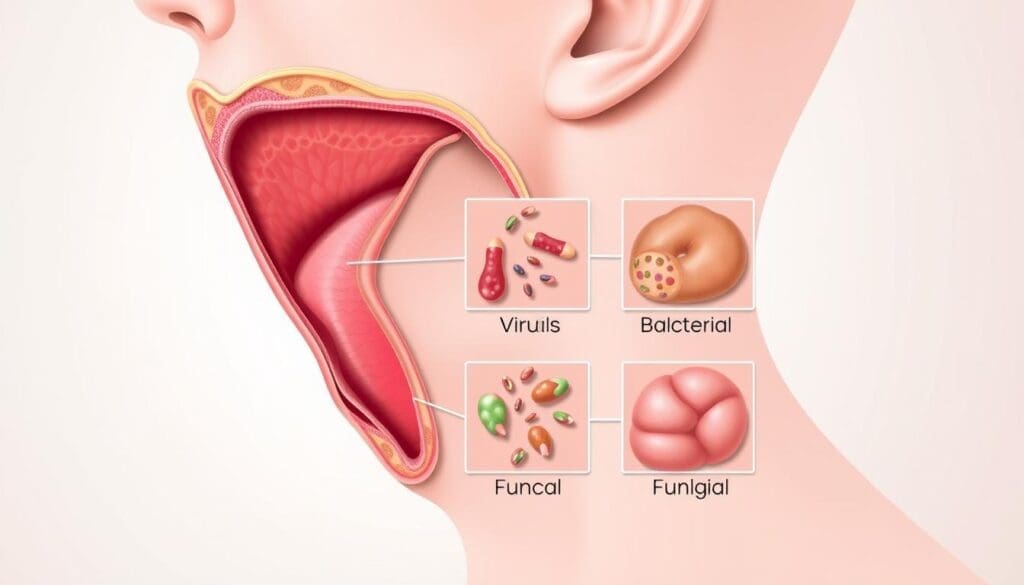Last Updated on November 27, 2025 by Ugurkan Demir

Do you have a sore throat that won’t go away? Pharyngitis, or sore throat, is a common issue. It causes discomfort, pain, or scratchiness in the throat because of inflammation in the pharynx.
Pharyngitis meaning explained: The general term for throat inflammation. Learn the common causes, symptoms, and distinction between viral and bacterial.
It’s not a disease, but a symptom of an infection, usually bacterial or viral. Dealing with pharyngitis can be tough. At Liv Hospital, we focus on giving you the best care possible.
Most sore throats come from colds, the flu, or other viral infections. Knowing the causes and symptoms of pharyngitis helps us diagnose and treat it right.

Pharyngitis is a common condition that causes inflammation in the pharynx. This is the part of the throat behind the mouth and nasal cavity. To grasp pharyngitis, we must know the throat’s anatomy, distinguish it from a sore throat, and look at its commonality and who it affects.
The throat, or pharynx, is a muscular tube that links the digestive and respiratory systems. It runs from the base of the skull to the esophagus. It’s divided into three main parts: the nasopharynx, oropharynx, and laryngopharynx. The pharynx is key for swallowing and breathing.
The throat’s anatomy includes several important structures: – The nasopharynx, the upper part, behind the nasal cavity. – The oropharynx, the middle part, behind the mouth. – The laryngopharynx, or hypopharynx, the lower part, leading to the esophagus and larynx. – The tonsils, masses of lymphoid tissue on either side of the oropharynx, aiding in infection fight.
Pharyngitis and sore throat are often confused, but they’re not the same. A sore throat can be caused by many things, including pharyngitis. Pharyngitis is inflammation of the pharynx, leading to sore throat, difficulty swallowing, and other symptoms.
The main difference between pharyngitis and a sore throat is their causes and affected areas. Pharyngitis involves inflammation of the pharyngeal tissues, caused by infections, irritants, or other factors.
Pharyngitis is common and affects people of all ages, but some groups are more at risk. Children and young adults are often hit hard because of viral and bacterial infections in schools and daycare.
Age Group | Prevalence of Pharyngitis | Common Causes |
Children (0-12 years) | High | Viral infections, bacterial infections (e.g., streptococcal) |
Teenagers and Young Adults (13-25 years) | Moderate to High | Viral infections, bacterial infections, lifestyle factors (e.g., smoking) |
Adults (26-64 years) | Moderate | Viral infections, acid reflux, environmental irritants |
Older Adults (65+ years) | Low to Moderate | Dry air, acid reflux, infections |
Knowing who gets pharyngitis and how often helps us spot risks and take steps to prevent it.

Pharyngitis is not just one condition. It can be divided into several types based on its cause and how long it lasts. Knowing these types helps doctors diagnose and treat it correctly.
Pharyngitis can be either acute or chronic. Acute pharyngitis is usually caused by viruses and starts suddenly. It often goes away in a few days. Chronic pharyngitis, on the other hand, lasts longer and might be due to ongoing irritation or infection.
It’s important to know if you have acute or chronic pharyngitis. Acute pharyngitis might just need symptom relief. But chronic pharyngitis needs a more detailed treatment plan.
Viral pharyngitis is the most common type. It’s often caused by viruses like the common cold or flu. Symptoms include a sore throat, fever, and feeling unwell. Treatment focuses on easing symptoms and boosting the immune system.
Bacterial pharyngitis, also known as strep throat, is caused by bacteria like Group A Streptococcus. This type needs specific antibiotics to prevent serious problems and stop it from spreading to others.
To diagnose bacterial pharyngitis, doctors do throat swab tests. Antibiotics are used to treat it. It’s key to finish all the antibiotics to treat it fully and avoid it coming back.
Pharyngitis can be caused by infections, allergies, and irritants. Knowing the cause helps us treat it effectively. Viral infections like the common cold and flu are common causes. Bacterial infections, such as strep throat, can also cause it and spread if not treated.
Viral pharyngitis often comes from the common cold and flu. Bacterial pharyngitis usually stems from strep infections, leading to strep throat or sourthrout. Allergies, dry air, and irritants like smoke and pollutants can also cause it, leading to fangiritis or pharnygitis.
It’s important to know what causes pharyngitis to choose the right treatment. By identifying the cause, we can prevent it and manage symptoms better.
Pharyngitis is when the pharynx gets inflamed. This leads to a sore throat, trouble swallowing, and a fever. It’s a sign of an infection, not a disease itself.
Many things can cause pharyngitis. Viruses, bacteria, allergies, and irritants can all play a part. Knowing the cause helps find the right treatment.
Acute pharyngitis is short-term and usually caused by infections. Chronic pharyngitis lasts longer and might be due to irritants or other conditions.
Yes, pharyngitis can spread, mainly through viral or bacterial infections. Good hygiene and avoiding close contact can help stop it from spreading.
Symptoms of viral pharyngitis include a sore throat, fever, and trouble swallowing. You might also have a cough, runny nose, and feel tired.
Bacterial pharyngitis is treated with antibiotics. It’s important to finish the whole treatment to get rid of the infection.
Yes, allergies can lead to pharyngitis. When you’re exposed to an allergen, it can cause inflammation in your throat, leading to symptoms like a sore throat and trouble swallowing.
Oropharyngitis is inflammation of the oropharynx, which is the middle part of the throat. It’s often called the same as pharyngitis because the oropharynx is part of the pharynx.
To prevent pharyngitis, you can reduce your risk by practicing good hygiene, avoiding close contact with others, and managing allergies and irritants.
A sore throat is a symptom of pharyngitis, but not all sore throats are pharyngitis. Pharyngitis is a specific condition with inflammation of the pharynx. A sore throat can have many causes, including infections, allergies, and irritants.
National Center for Biotechnology Information.. What Is Pharyngitis Understanding Causes and Symptoms Do. Retrieved from https://www.ncbi.nlm.nih.gov/books/NBK519550/
Subscribe to our e-newsletter to stay informed about the latest innovations in the world of health and exclusive offers!